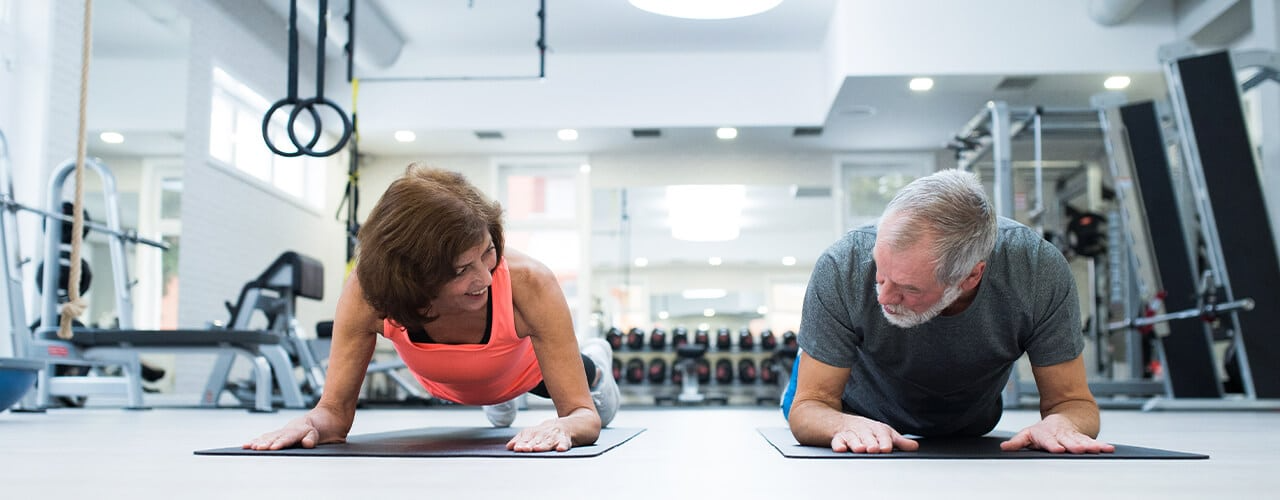The relationship between core strength and balance is something that has been widely discussed within the physical therapy field for several years. Your trunk contains several core muscles that work to prevent injuries and other physically limiting conditions, such as low back pain or balance and gait disorders. When your core is strong, it helps keep you upright and decreases your risk of falling. If you are interested in learning more about how our services can improve your balance, contact Carlson ProCare today!
How Are Core and Balance Related?
There are three systems in your body that help to control your balance: the Visual System, the Vestibular System, and the Proprioceptive System.
The Visual System refers to the messages that your brain and eyes send to each other, in order to help you see. Your eyes send signals to your brain about your position in relation to the world around you.
The Vestibular System refers to your inner ear: three semicircular canals and two small otolith organs that are filled with fluid, lined with small hairs, and contain calcium carbonate crystals, that functions as a sort of “carpenter’s balance,” in order to keep you level. If you’ve ever felt dizzy, it generally means that the inner ear is a little bit off-balance.
The Proprioceptive System is the one that involves your spine and your core. Proprioception nerves are sensory nerves throughout the body that tell your brain where your body is in space. They make you aware of your posture, your position, and aware of where things are around you.
In order to stay balanced, your need equilibrium in all three systems. A weak core is one element that can make you feel off-balance and cause you to stumble or fall.
The Impact of Core Muscles on Stability
When many people think of core muscles, they immediately picture the abs, the “6-pack”—but there are so many more! In fact, there are four distinct groups of core muscles! Most science talks about two groups: the superficial abdominals and the deep abdominals
The deep abdominals (transverse abdominis, pelvic floor, diaphragm, and intrinsic back muscles) attach to your spine and they help to stabilize your core. The superficial abdominals (rectus abdominis, obliques, quadratus lumborum) work in conjunction with the deep core muscles whenever you need to move your body from point A to point B—or, essentially to do most physical activities.
When we think of “core stability,” we are thinking of the deep core muscles. When we think of “core strength,” we are thinking of the superficial abdominal muscles. Engaging in physical therapy will help you to train both your inner and outer core muscles, in order to achieve better balance and movement.
Physical Therapy for Core Strengthening and Balance Training
Core strength can be improved upon with simple body weight exercises—you don’t need special equipment. Many physical therapists will recommend that you start with a simple exercise known as “abdominal bracing” or “core engagement” or “drawing in maneuver.”
Abdominal Bracing Exercise
To accomplish this exercise, you can be in any position. It’s easiest to learn while lying on your back on a firm surface, like a yoga mat on the floor, with both of your knees bent, and your hands resting on your stomach to feel the muscles.
- Have Good Postural Alignment: Whether lying down, sitting up, or standing, make sure you are in a good posture, with your shoulders and hips centered, your feet and knees lined up with your hips, your spine straight, and your head in line with your spine
- Belly Button In: Gently pull in your stomach, like you are trying to draw your belly button in toward your spine. Your stomach should flatten a bit. If it sticks out more than when you started, you’re using to wrong muscle. Try again, visualizing your hips moving closer together behind your belly button, feeling your stomach flatten, as you draw your belly button in to your spine.
- Lift Your Bladder Up: Your pelvic floor is a muscle hammock slung between your hips. It holds your bladder and organs inside your body. It also controls bowel and bladder function, and it’s an important part of your core. Imagine you are lifting your bladder up behind your belly button, like a Kegel exercise, like you are trying to stop the flow of urine.
- Breathe! Inhale Belly Out, Exhale Belly In: Muscles don’t work right if you hold your breath. Your diaphragm is an umbrella-shaped muscle under your ribs. When you inhale, the diaphragm pushes your belly out to allow your lungs to inflate. When you exhale, your diaphragm lifts inward and upward to squeeze the air out of the lungs.
- Move: While keeping your good posture, keeping your belly button in, keeping your bladder up, and while breathing, try moving your legs without letting go of your core and without holding your breath.
This takes practice! Ideally, your core muscles should be strong enough to hold that position for at least 30 seconds. However, if you are out of shape, you may have to build up to this time. Start with 5 or 10 seconds. Try repeating the exercise 10 times. This should be a painless exercise, so if you notice any pain while performing it, stop and rest. As your core gets stronger, your physical therapist will move you on to more difficult exercises, such as yoga, planks, and bridges.
If you have been struggling with your core strength or balance, we can help. Contact Carlson ProCare today to learn how our physical therapy services can improve your core strength and balance, and get you back on your feet!
References
Dougherty, John J. (2011.) The anatomical “core”: a definition and functional classification. Osteopathic Family Physician (2011) 3, 239-245. <https://www.ofpjournal.com/index.php/ofp/article/view/231/179>.
Harvard Health Publishing. (2014.) Improve Your Balance by Strengthening Your Core. February 1, 2014. <https://www.health.harvard.edu/balance-and-mobility/improve-your-balance-by-strengthening-your-core>.
Sorgen, Carol. (2004.) Balance Your Way to a Stronger Body. April 15, 2004. <https://www.webmd.com/fitness-exercise/features/balance-your-way-to-stronger-body>.


